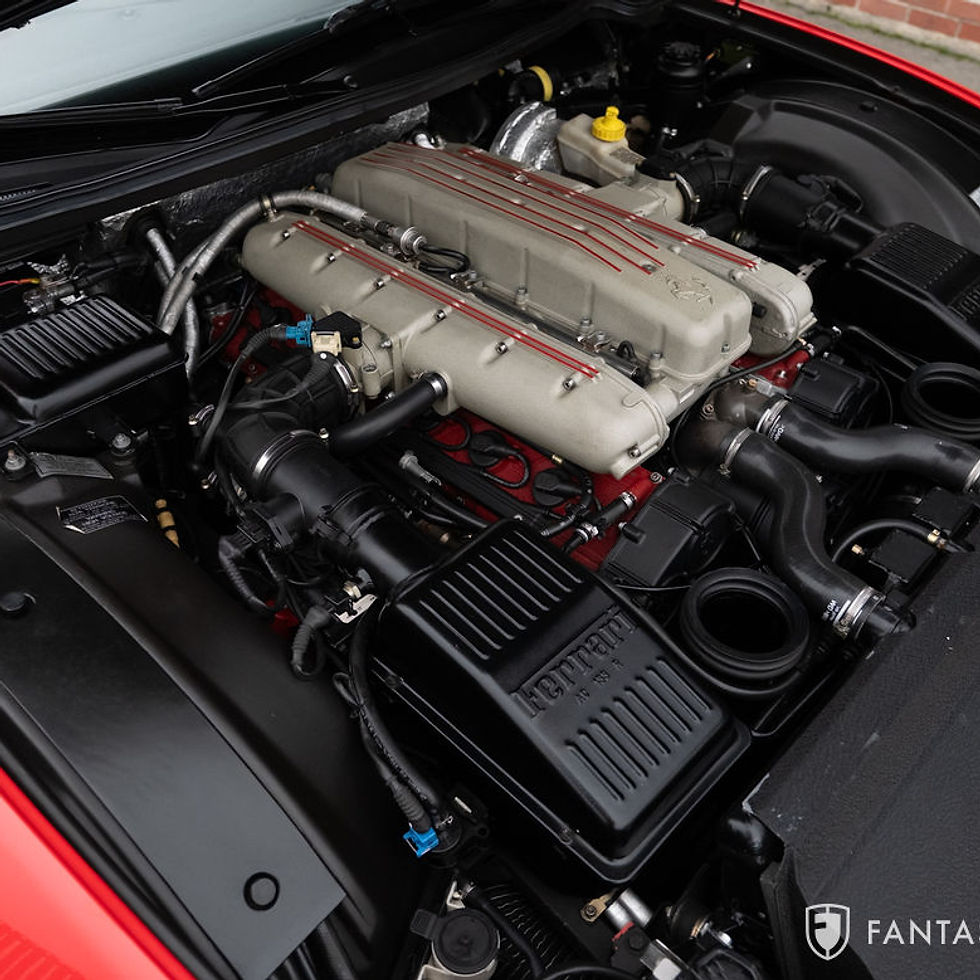Chassis 0146 (0346) was the last of the second-series 166MMs made. The new-for-1953 version was introduced for privateers to contest two-litre sports car racing. Thirteen chassis were allocated with a 2250mm wheelbase, with power provided by the same two-litre, all-alloy single overhead cam per bank V12, but now with 6-port cylinder heads and three gurgling, quad-choke downdraught Weber 36 IF/4C carburettors.
Another revision was the use of roller cam followers, as trialled on Ferrari’s Aurelio Lampredi-designed ‘long-block’ V12. These modifications helped reinvigorate the ‘Colombo’ unit, increasing revs to 7,200rpm and boosting power to a claimed 160bhp. This resulted in a hike in top speed from 110mph to a highly-impressive 137mph, depending on gear ratios. Wet sump lubrication was via an oil cooler mounted vertically to the right of the water radiator. Fuel supply from the 117-litre fuel tank was delivered by twin front mounted mechanical fuel pumps. Power was transmitted to the rear wheels via a five-speed Type 212/ EU ’box (with synchromesh on third and fourth gears) and a single plate mechanically-actuated clutch. The front end was suspended by means of a transverse leaf spring arrangement, the rigid rear axle set-up comprising semi-elliptic springs with Houdaille lever-type dampers all-round. The addition of twin parallel trailing arms on each side at the rear on Series II – or Tipo 166MM/53 - cars was also a major step forward in terms of ride and handling over earlier editions.
The efficient braking system was hydraulically operated and had aluminium drums with steel liners, with Route Borrani providing the oh-so attractive wire-wheels. According to the factory build sheets, our car was completed in July ’53, and signed off by Ing. Franchini. Intriguingly, after the first test he noted: ‘Scarso di Potenza a tutti I regimi’. Roughly translated, this means ‘A lack of power at all levels’. Later annotations state: ‘Motore complete di carburatori modificati.’ Pininfarina’s own records claim that the coachwork was finished on July 9th of that year, the first owner being industrialist Kurt Zeller.
The German owned an iron and steel works in Hammerau, a small town southeast of Munich located close to the Austrian border. Zeller clearly had the means to indulge himself, having previously owned a 212 Inter Coupé. Just to irritate future historians, this car was returned to the Ferrari works upon taking delivery of the 166. As was often the case around this time, the new car assumed the identity of the old one, ostensibly to circumnavigate crippling import duties on luxury goods. Thus, it ostensibly became chassis 0146 E and carried the existing registration number, AB-39 4060.
An amateur racing driver from a time before the term became a slur, Kurt didn’t waste any time fielding his new toy. He teamed up with his younger brother, factory BMW motorcycle star Walter Zeller, and participated in August’s ADAC Nürburgring 1000km, round five of the inaugural World Championship for Sports Cars. Lining up with Modena’s new big guns, a trio of 375MMs driven by GP aces including eventual winners Alberto Ascari and Giuseppe Farina, the Zellers retired the car late in the race after running out of fuel.
A degree of confusion surrounds which sibling drove and which one sat in the navigator’s seat, but they claimed third place in the 1600-2000cc class. The following year saw Kurt Zeller and new wingman Alois Willberger take part in the Tulip Rally. They placed a highly-respectable thirteenth from 128 finishers and claimed class honours. The 166MM was sold shortly thereafter to a dealer who in turn moved it on to a US serviceman who was stationed in Germany.
The car then headed Stateside once his tour of duty was completed. In February 1956, the car was sold once again and, by the early ’60s, it had found its way to Connecticut where its youthful owner managed to damage the engine. A 250GT block was substituted. The rectangular fog lights fitted by Zeller remained. The car was subsequently traded between dealers in Trenton, New Jersey and Hampton Falls, New Hampshire before being acquired by Georgia-based Greg Miller in 1974. By this time, the car was in need of restoration.
The car then sat in the grounds of Miller’s home in Lawrenceville near Atlanta where, over the next four years, it slowly communed with nature. Scroll forward to September 1979, and the car was saved by Gerald T. Sutterfield who moved it into dry storage at his home in West Palm Beach, Florida. The noted marque authority had hitherto saved several important ’50s Ferraris, and 0346M was stripped and the chassis part restored, only for other endeavours to take precedence. The turning point arrived in May 1999 after fellow collector, Florida’s Wayne Sparling, gifted the original engine block to Sutterfield from his cache of parts.
The scheme never really found traction, though. Two years later, word began to spread that the restoration project was for sale. Enter DK Engineering’s founder, David Cottingham. A visit to Florida resulted in a complete and detailed inventory. It soon became clear that the 166MM was largely complete and remarkably original. Pinin Farina job numbers were still stamped and chalked on several parts, not least the fuel tank and inner panels. The chassis had been repainted in the wrong colour, but there were no signs of prior accident damage, whilst the factory-installed gauges, switchgear, wiring loom and even the steering wheel were also still in place. The car was acquired in 2002 and with a sponsor in place, it was shipped to the UK and DK Engineering embarked on a total restoration.
This was no easy task, not least because every attempt was made to retain as much of the car’s originality as possible. Period images of the car outside the Pinin Farina factory at 107 Corso Trapani, Turin proved invaluable. Clive Smart of Shapecraft was tasked with repairing the car’s body, which proved somewhat taxing. The recreation of the missing grille, for example, required three attempts before Cottingham was satisfied. Inevitably, there were challenges with restoring thin aluminium coachwork. Handmade bodies, by definition, are not symmetrical, and Pinin’s ’shells were typically smoothed over with filler prior to painting. However, every effort was made to retain as much originality as possible and any sheet metal removed has been retained with the car for posterity.
Then there was the small matter of replacing the missing windows and frames, with Pilkington Glass being commissioned to recreate the original split windscreen. As in period, the side glazing and curved rear screen were shaped from Perspex. Other details, such as the side wind deflectors and the bonnet-sited fly screen were also remade.
In order to prolong the V12’s lifespan, improvements were made without affecting the visual appearance of the running gear. A lighter flywheel was also installed along with an easier to operate clutch. Sourcing the few missing parts was time-consuming, to say nothing but expensive, with the missing fuel pump being found at auction. Recreating the period colour scheme wasn’t without its headaches either, but thankfully elements of the original blue was discovered inside the car. As with all DK’s top level restorations, the paintwork was trusted to their usual supplier. The finishing touch was a perfectly replicated chrome serif ‘D’ which was mounted to the car’s pert rump. The restoration was completed in early 2005, the car passing to Dutch collector Henk Koel later that year.
In 2006, he had the honour of returning the car to Italy for the first time in more than 50 years when it was displayed at the Concorso d’Eleganza in the grounds of Ville d’Este. The 166MM was subsequently garlanded with honours at the concours at Paleis Het Loo only a few months later. It has since appeared in numerous articles in titles such as Classic & Sports Car, Cavallino and Ferrari World. Not that it was a trailer queen, Koel exercising the car on the Ennstall Classic in Austria among other events.
There aren’t enough adjectival phrases that can adequately describe just how lovely this car is. Photographs don’t really lend a sense of scale. It’s smaller than you think; more delicate-looking than its bigger-boned 375MM cousin. It looks quite unlike any other 166, being tauter and less fussy than most comparable Vignale-bodied offerings of the period. So many stylistic elements here were later transposed onto other Pinin’ GTs, not least the signature Perspex-ensconced headlights, the ‘egg crate’ grille and push-button door handles. Then there are those large ducts aft of the doors which are in place to cool the rear tyres rather than the drum brakes.
Step inside and all the ’50s Italian racer-reference points are present and correct right down to the Veglia instruments, original alloy-spoked steering wheel and body-coloured dashboard. It may be pared back in true competition-style, but it is elegant with it. Even the cross-bracing to the roof, or the simple pull cords inset in the doors are period-correct and not out of place. What’s more, it’s far more spacious than preconceptions might have you believe, with plenty of headroom for the taller driver. It’s truly, really lovely.
The car received Ferrari’s Classiche certification in December 2018 confirming the originality of the engine, suspension and body. DK Engineering sold the car from Koel to its current custodian in 2019 who promptly enjoyed it as intended on the Mille Miglia. In the years since, the car has been used sparingly in sunnier climes returning to DK in September 2025.
The significance of this 166 should not be underappreciated; this car ticks all the boxes, with period competition history in both the World Championship for Sports Cars and internationally-significant rallies. It is also exquisitely beautiful. Perhaps more than anything, though, its worth – as opposed to its value – lies in what it represents, or rather what it led to. All other Pininfarina-styled Ferrari GTs owe a debt to the car pictured here. That’s quite a legacy.

















































































